Turkish Pide Bread Recipe (Ramazan Pidesi) is incredibly easy and fun to make! It only contains a few basic ingredients which creates a deliciously soft and fluffy bread!
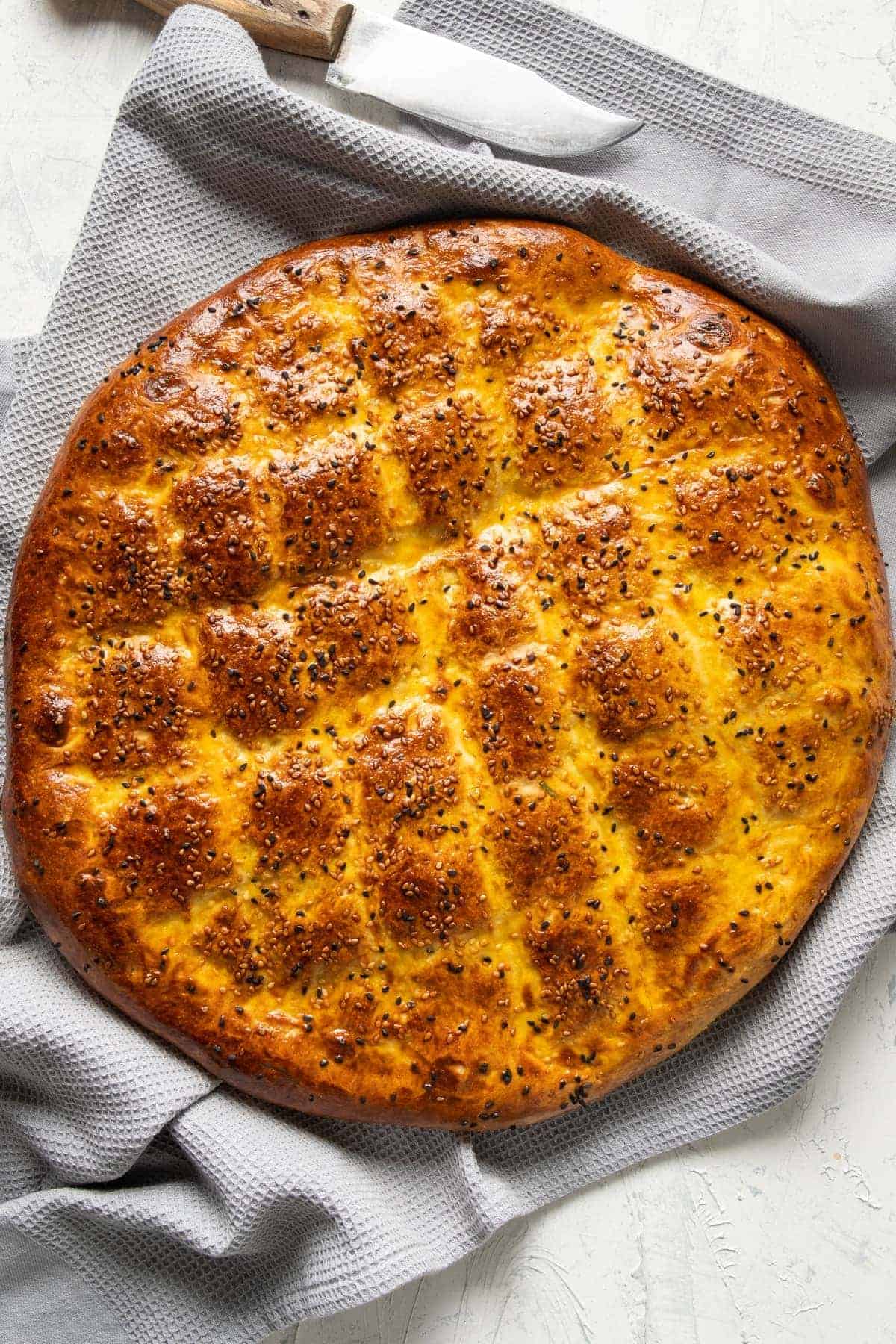
Pide bread is one of the traditional food in Turkey like bazlama bread, simit and lavash bread. Its dough is shaped by hand, dented with wet fingertips and then topped with sesame seeds. It is specially sold in bakeries during Ramadan.
You can't think of meaty doner kebab or Bursa iskender kebab without pide.
In today’s article, we will be having a look at what exactly Turkish bread pide is, from the ingredients used, to the correct and authentic shaping and cooking method. We will also look at some storage methods, and how to best serve this flatbread.
Jump to:
What Is Ramazan Pidesi?
Bread means ekmek in Turkish and there are several types of ekmek in Turkish cuisine. This Ramadan bread is just one them.
Pide, pronounced “pee-DEH”, is a staple bread in all Turkish households and is especially popular during the month of Ramadan.
This holy month is dedicated to spirituality and reflection and also has a time for fasting during the day. Once Ramadan fasting has been broken, a feast of flavors awaits and this special bread is always the star of it.
Ramadan bread, or in Turkish Ramazan pidesi, is a leavened flat bread that uses yeast. It is traditionally shaped by hand into either a circle or oval.
The texture of the bread itself is unmatched! It is soft, fluffy, and very porous. Another thing we love about this bread is its simplicity. It only contains a few basic ingredients, but the ratios they are used in leaves you with a beautifully balanced palate.
Pide bread is often served at iftar dinner time in Turkish culture during Ramadan called. The best thing to serve with soups. And traditionally you end the meal with the delicious Ramadan dessert gullac.
Pide Bread vs Pide
Both pide bread and pide are types of Turkish flat bread, but they are completely different.
We know that most of you love pide (pizza-like flat bread), which is one of the most popular Turkish foods. This bread recipe shouldn’t be confused with that one!
So what are the differences? Please read on!

Pide Bread:
- Shape: Typically oval or circular.
- Texture: Soft and pillowy.
- Appearance: Features indentations on the top, often sprinkled with sesame seeds and nigella seeds.
- Serving Tradition: Traditionally paired as a side dish, complementing soups or main courses.
Pide:
- Shape: Distinctly boat-shaped, reminiscent of a pizza.
- Toppings: Adorned with a variety of fillings, including cheese, meat, and vegetables.
- Design: The edges of the pide are folded over, encapsulating its toppings.
- Serving Tradition: Typically served as a standalone main dish.
In a nutshell: Pide Bread is a soft, seeded bread often accompanying other dishes. Pide is a boat-shaped, topped delicacy, enjoyed as a primary meal.
Is It The Same As Pita?
No, pide bread and pita are not the same, though they both originate from the broad family of flatbreads. Here are the primary differences:
Origin:
- Pide bread: It is a traditional Turkish bread.
- Pita: This bread has Middle Eastern and Mediterranean origins.
Texture & Shape:
- Pide bread: It is shaped by hand into an oval or circle. A border is created by hand, as well as diagonal lines to form diamonds inside.
- Pita: Generally round and flat. It is known for its characteristic pocket that forms in the middle when baked. This pocket is ideal for stuffing with various fillings.
Usage:
Ingredients
This Turkish bread recipe only calls for a few simple ingredients that you already have at home.
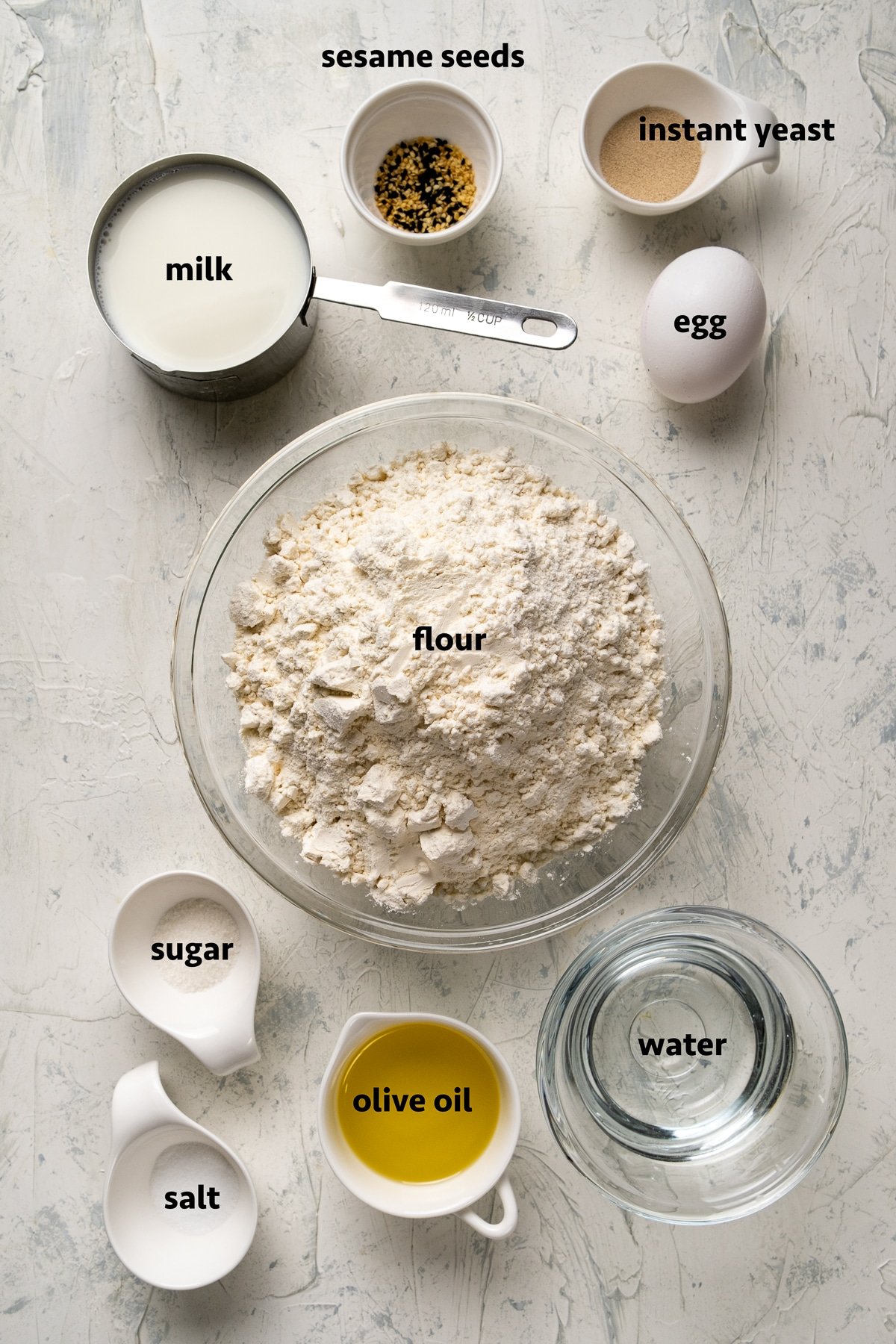
- Flour – We would recommend using all-purpose flour and make sure to have a bit more than 3 cups available for dusting and shaping. Bread flour works fine too.
- Sugar and Salt – These ingredients help activate the yeast and also helps to balance the flavors.
- Instant yeast – For this recipe, instant dry yeast works best as you can add it straight into the mixture.
- Olive oil – Oil acts as a tenderizer in recipes and will help improve the texture of the bread.
- Milk – Your milk must be lukewarm to help activate the yeast. Milk also enriches the dough and helps add color.
- Water – The water also has to be lukewarm to activate the yeast. The water will be our binding ingredient in this recipe.
- Egg yolk and Milk – This mixture will help add color to the top of the pide.
- Sesame seeds – You can choose either white or black sesame seeds for your topping. We love using the black ones as they provide a beautiful contrast.
How To Make It
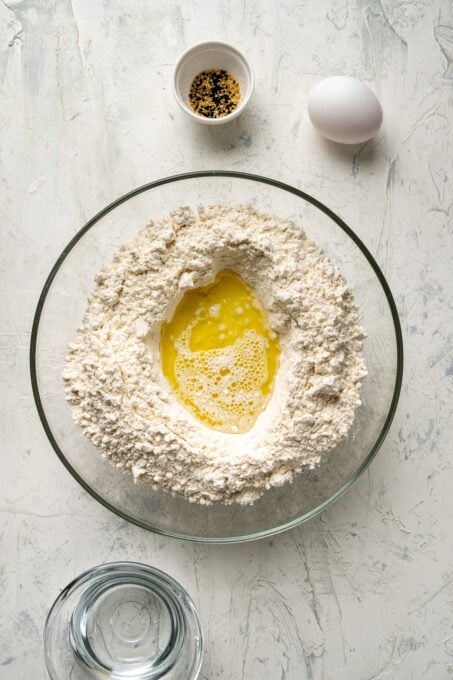
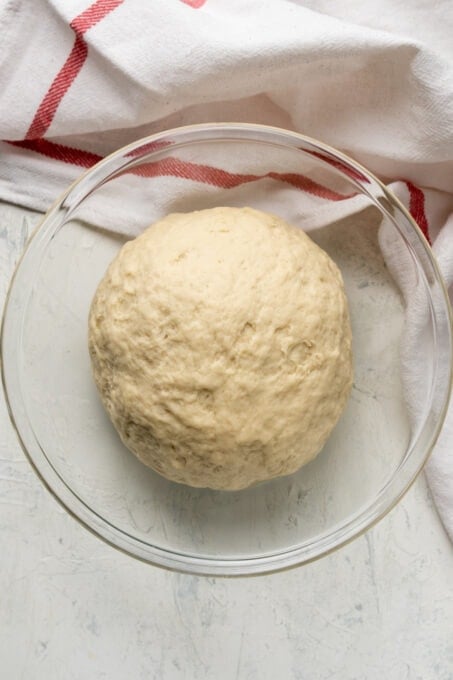
Prepare the dough:
Combine the flour, sugar, salt, and yeast in a large bowl. Add the oil and milk and gently mix the ingredients together with your hands. Slowly add water and continue mixing until you get a soft sticky dough. Cover the dough and allow it to rest until it has doubled in size.

Shape the dough:
Once the dough has risen, gently fold out the air. Place the dough on a baking sheet and shape it into a circle or oval with wet fingertips. Make a circle inside the dough, leaving a 3cm border that will act as the edge of the bread.
Using your wet fingertips again, make a deep diagonal pattern on the dough. Allow it to rest for another 15 minutes.
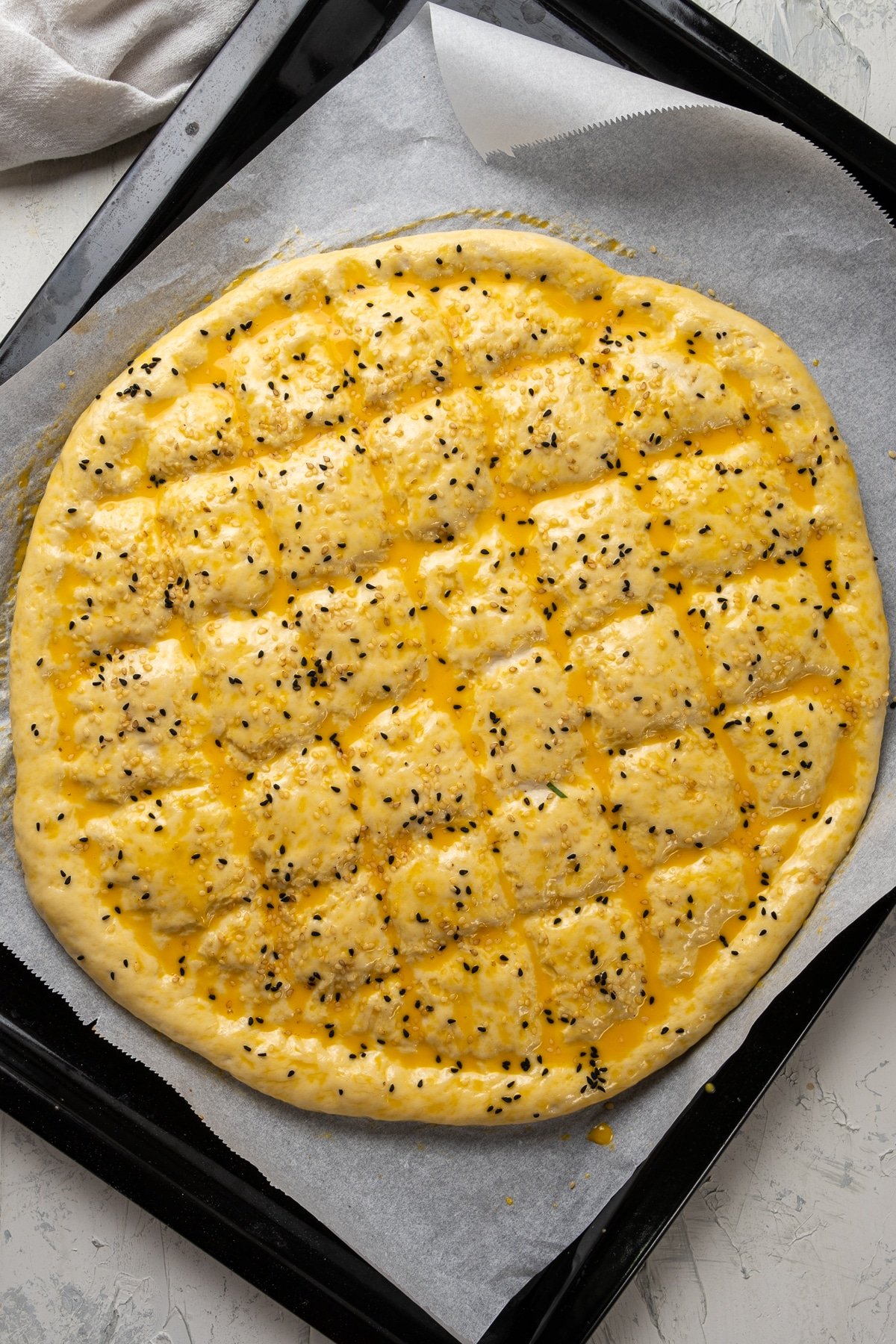
Make egg wash and bake:
While the dough is resting, preheat the oven to 400°F (200°C). Line a baking sheet with non-stick paper, or you can use a pizza stone.
Combine the egg and yogurt (or milk) together and whisk well. Brush the egg wash over the bread and sprinkle the sesame seeds over it. Bake the pide bread for about 20 minutes or until it is golden brown. Reduce the heat to 320°F (160°C) and bake another 5 minutes.
Remove it from the oven and cover it with a damp kitchen towel. Allow it to rest for 15 minutes before slicing and serving it.
What Do You Eat It With?
This Turkish flatbread can be eaten on its own or covered with delicious salted butter but it is also traditionally served as one of the sides for kebabs. We love serving it with kebabs like lamb shish kebab, chicken doner kebabs and Adana kebab.
Another popular way to serve pide ekmek is with soups like Turkish lentil soup, tarhana soup, ezogelin soup and domates çorbası. Also, it is great at breakfast with Turkish eggs and menemen too.
Also, we love to dip a piece of pide bread into dips like ezme.
Storage
Ramadan pide bread can be stored at room temperature in an airtight container for about a week.
Keeping your bread in the refrigerator will extend the shelflife, although it does have the tendency to dry it out, so we wouldn’t recommend it.
Another alternative is to freeze your cooked pide breads. To do so, simply wrap each bread whole or sliced in ziploc bags.
Make sure to write the details of the bread on the bags before placing them in the freezer. Frozen pide bread will last up to 3 months!
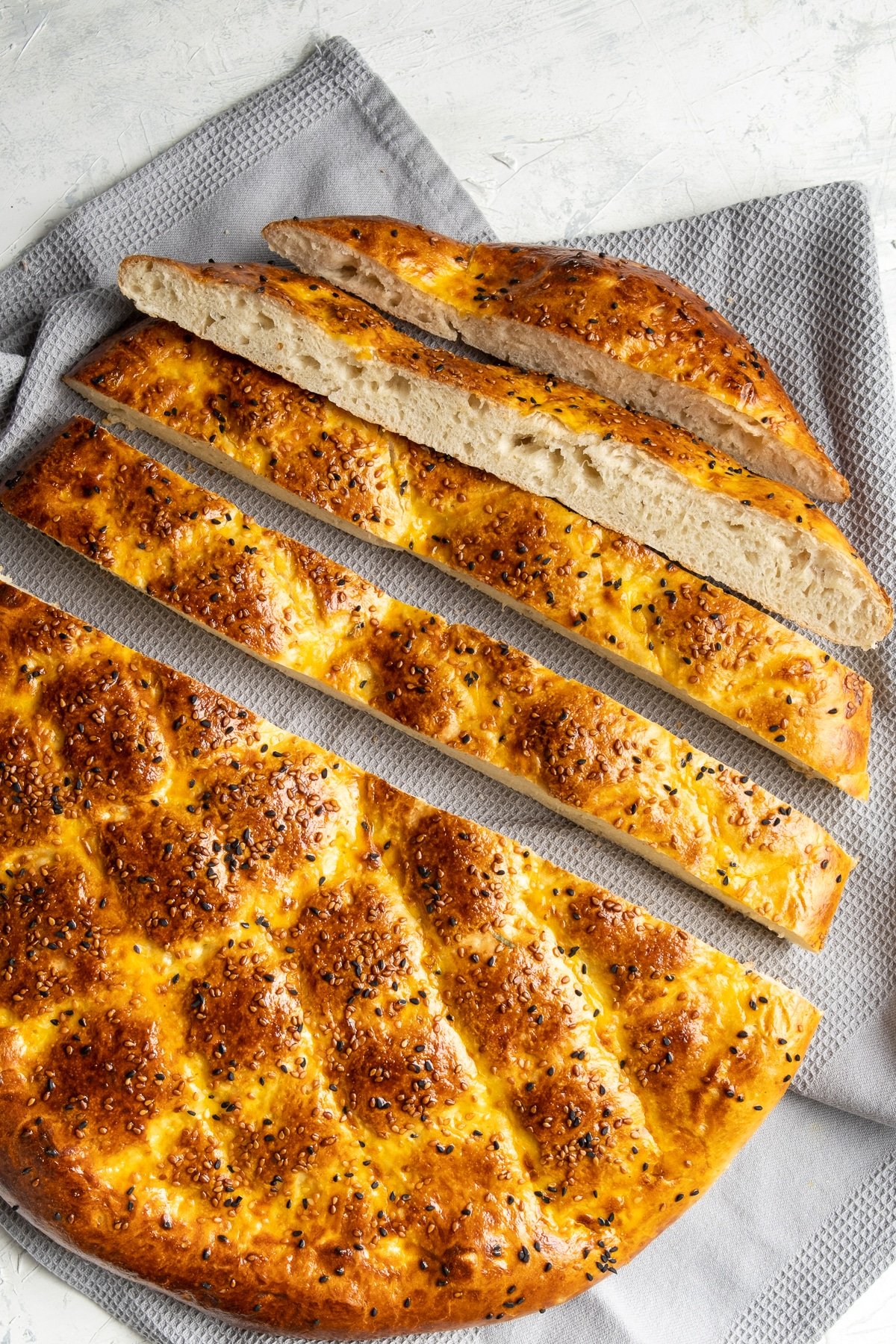
How To Reheat It
Ramazan pidesi can be reheated in a pan covered with a lid. Make sure to do so over low heat to prevent the pide bread from drying out or burning. Alternatively, you can reheat it in the oven.
A useful trick is to sprinkle some water over the bread before reheating it to help keep it soft and fluffy.
More Turkish Breads
As always: If you make this recipe, let us know what you think by rating it and leaving a comment below. And post a pic on Instagram too—tag @give_recipe so we can see!
Sign up for the FREE GiveRecipe Newsletter to get the new recipes into your inbox! And stay in touch with us on Facebook, Pinterest, YouTube and Instagram for all the latest updates.
📖 Recipe
Turkish Pide Bread - Ramazan Pidesi
Homemade pide bread made with instant yeast and topped with egg wash and sesame seeds.
- Prep Time: 15 minutes
- Cook Time: 25 minutes
- Total Time: 40 minutes
- Yield: 1 large loaf
- Category: Side Dish
- Method: Baking
- Cuisine: Turkish
Ingredients
Dough:
-
3 cup flour
-
1 teaspoon sugar
-
1 teaspoon salt
-
2 teaspoon instant yeast
-
3 tablespoons olive oil
-
1 cup lukewarm milk
-
2 and ½ tablespoon warm water
Topping:
-
1 egg yolk
-
1 tablespoon milk or yogurt
-
nigella seeds and sesame seeds
Instructions
- In a large bowl, whisk together flour, sugar, salt and instant yeast.
-
Add in olive oil and milk.
-
Gently mix with your hand.
-
Slowly add in water and keep mixing with your hand.
-
When it gets too sticky, slightly wet your fingertips and keep mixing. The result will be a sticky soft dough. Don’t knead it.
-
Grease the bottom and the edges of another bowl and transfer the dough into it. Cover it either with stretch film or a clean kitchen towel and let it rise. It takes between 40min-1.5 hours depending on the temperature.
-
Preheat the oven to 200C/400F. Line baking paper on a baking sheet. You can use a pizza pan or stone if you have it.
-
Gently release the air in the dough by turning it upside down in the bowl.
-
Transfer it onto the baking sheet and spread it in the pan, wetting your fingers occasionally and pressing on the dough. Give it a round or oval shape.
-
Wet your fingertips and make a circle on the dough leaving about 3cm from the edge. This will be the edge of the bread.
-
And then again with your fingertips make a diagonal pattern on it. It will rise when baking, and these patterns are likely to disappear. So press on the dough as much as you can when making the pattern. Let it sit for 15 min.
-
For the topping, whisk together the yogurt and egg well. Spread this mixture over the bread with a brush or your hand.
-
Sprinkle seeds over it and bake until golden, for about 20 minutes. Reduce the heat to 160C/320F and bake for another 5 minutes. Remove from the oven.
-
Transfer it on a clean kitchen towel. Cover it with a slightly dump kitchen towel and let it rest for 15 minutes. This will keep the bread softer.
-
After this time, slice and enjoy.
Nutrition
- Serving Size:
- Calories: 1918
- Sugar: 6.1 g
- Sodium: 2557.6 mg
- Fat: 58.1 g
- Carbohydrates: 298.6 g
- Fiber: 13.3 g
- Protein: 48.3 g
- Cholesterol: 184.8 mg


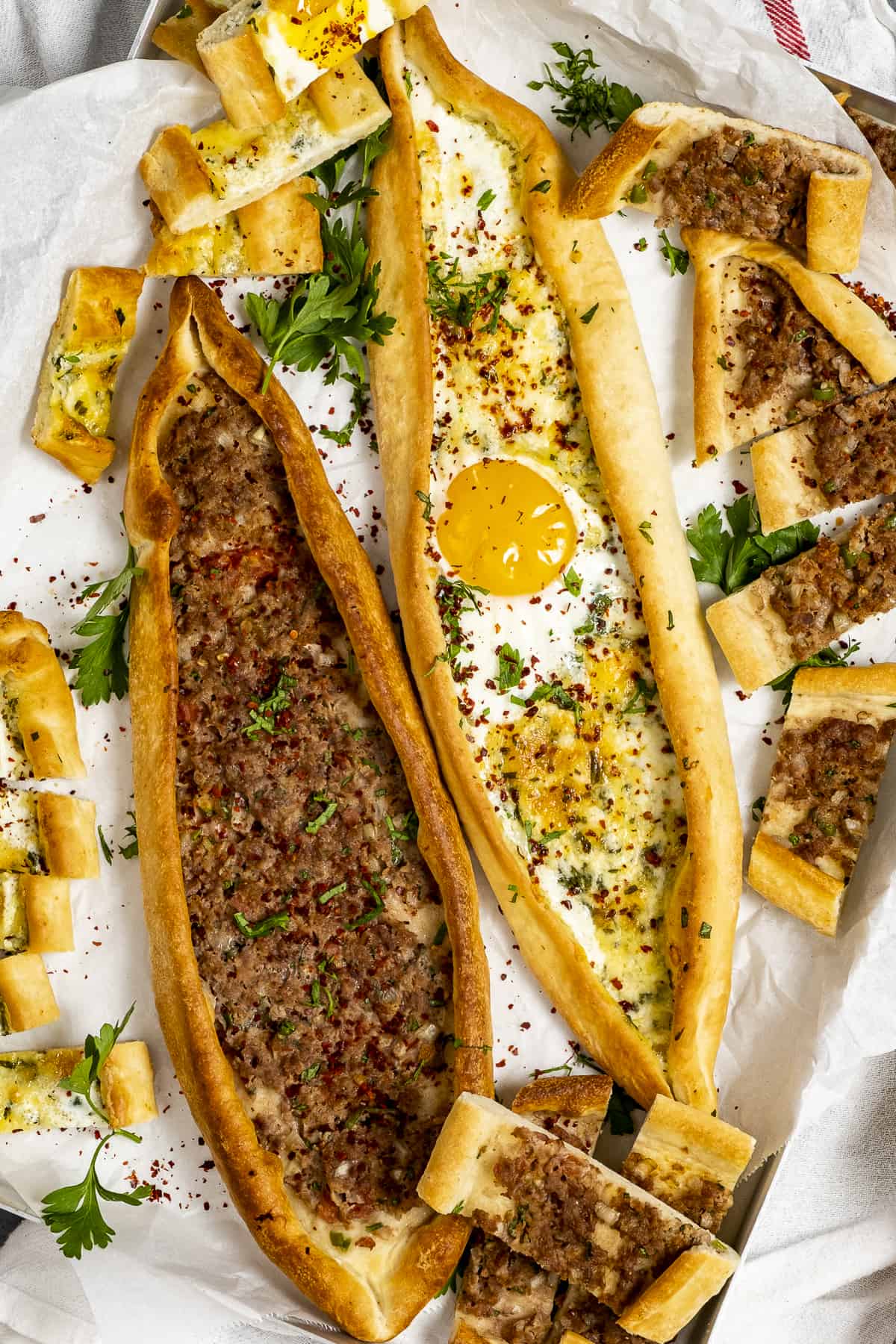
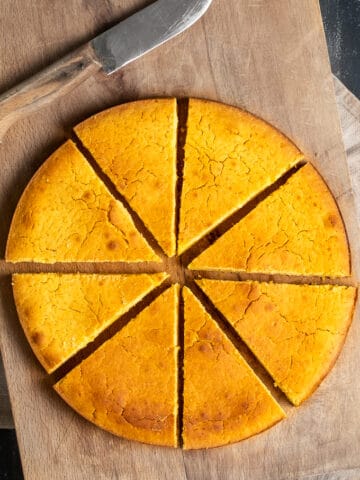
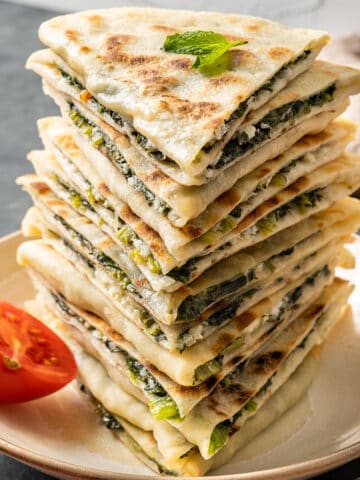
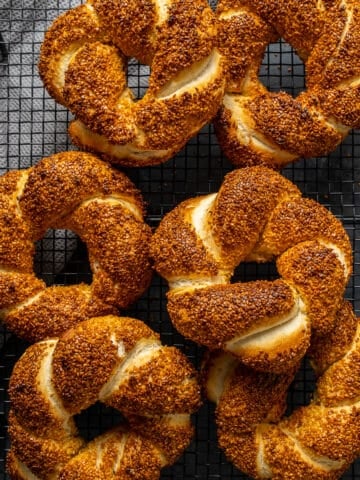
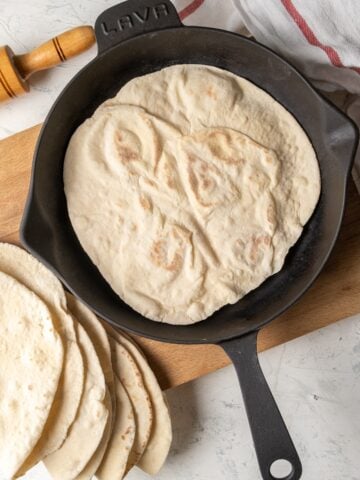
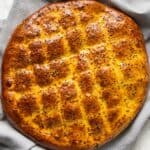
A says
What kind of flour should I use? Do I use plain or bread flour?
Zerrin & Yusuf says
You can use all purpose plain flour.
Christine Murray says
Hi
I make this Turkish bread quite often. the advantage of this is that it can be eaten on the same day and is yummie.
The sourdough bread that I make is made one day and baked the next so takes much longer. I find shop bought sourdough is too hard on my teeth.
Chris.
Cat says
Made this today along with the Turkish rice, kapuska and Turkish lentil soup. All the above recipes were easy to follow but this one needs adjusting. You stated the the “total” cooking time was 40min when in fact the bread takes at least 1-2 hrs to rise (in a hot kitchen) and then another 20 min for the second rise (which is not stated in the recipe either. I am a decent cook but making the bread at the same time as the other dishes derailed the serving time due to the recipe not being clear.
Having said all this, it does end up tasting good, but unless you are Turkish and grew up watching your mama cooking Pide, you wouldn’t know what to look for and how long it all takes.
sevil sevdiyar says
Please confirm that 1 cup is 250ml as opposed to 200ml Turkish bardak.
I am thinking baking recipes would be better by weight rather than volume.
Zerrin & Yusuf says
Yes, our cup is 250 ml. You are right, giving the measurements by weight is definitely better. We try to add them as we update the recipes.
Maureen says
This bread, like every other bread you have shared, was so easy to make and came out so perfectly that my Turkish husband said it was as good as he's ever had. I even had nigella seeds that I bought in Turkey to sprinkle on top. It was puffy and tender inside and the outside had a perfect crispness. It is so delightful I will probably be making it throughout Ramadan. Thank you, once again, for a wonderful Turkish experience here in Berkeley, CA. Every time I see a new recipe from you in my inbox it lights up my morning.
Love from Maureen.
Zerrin & Yusuf says
Hi Maureen,
Your comment is music to our ears 🙂 Such a lovely review from your husband! And we are so happy to hear that you are enjoying the recipes we send in our newsletter.
Thank you for letting us know about these.
Cheers,
Zerrin & Yusuf
Lorraine says
Excellent recipe, bread was lovely. Will definitely make this again.
Zerrin & Yusuf says
Hi Lorraine,
Glad you liked it 🙂
Roe says
Hmmm, I couldn't get mine to rise. I set it in a bowl, covered it with a damp towel, and laid down with my toddler for an hour.
I used King Arthur's unbleached All-Purpose flour and sifted my cups into the bowl to make sure there was air. It's got to be my yeast. It's not instant, it's quick rise, brand new. I think I have to use another proofing method for that and then add it to the dough later.
If you have any recommendations for it, please do share, I'm going to throw this bad batch out and try again.
Zerrin & Yusuf says
Hi Roe,
Sorry to hear you didn't get the desired result. Not sure if the problem is about the yeast. Instant yeast and quick rise yeast work the same way.
Were water and milk lukewarm? If they are cold or hot, this will negatively effect the dough rising. Another thing that effects the rising is the room temperature. If it is not warm enough, the dough won't rise. So the best place to let it rest is inside the oven.
Claudia says
Such a unique bread recipe! Loved how you shaped it with your fingertips!